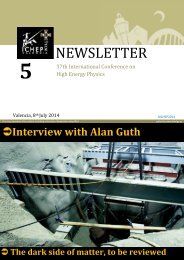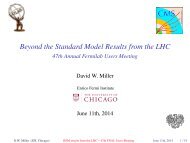PW_mar13_sample_issue
PW_mar13_sample_issue
PW_mar13_sample_issue
Create successful ePaper yourself
Turn your PDF publications into a flip-book with our unique Google optimized e-Paper software.
News & Analysis<br />
The budgetary shortfalls that have<br />
gripped the US over the past year<br />
seem ready to claim a new victim:<br />
the nuclear-physics programme. A<br />
report released early last month,<br />
by a subpanel of the government’s<br />
Nuclear Science Advisory Committee<br />
(NSAC) concluded that the<br />
country will have to close one of its<br />
three large nuclear-science facilities<br />
unless the field receives at least a<br />
small increase in government funding.<br />
It opted for the axe to fall on<br />
perhaps the best known facility –<br />
the Relativistic Heavy Ion Collider<br />
(RHIC) at Brookhaven National<br />
Laboratory in New York.<br />
The report had been commissioned<br />
last April by William Brinkman,<br />
head of the Office of Science<br />
at the Department of Energy (DOE)<br />
in response to indications that looming<br />
austerity could freeze the department’s<br />
$547m annual budget for<br />
nuclear physics. The panel charged<br />
with writing the report – led by<br />
nuclear physicist Robert Tribble of<br />
Texas A&M University – considered<br />
three budget scenarios for the<br />
next five years: zero growth, annual<br />
growth at a level similar to inflation,<br />
as well as a “modest increase” of<br />
1.6% annually above inflation.<br />
Only under the last scenario, the<br />
panel concluded, could the country<br />
operate all three of its major<br />
nuclear-physics facilities. In addition<br />
to the 13-year-old RHIC, these<br />
are the Continuous Electron Beam<br />
Accelerator Facility (CEBAF) at the<br />
Thomas Jefferson National Accelerator<br />
Facility in Virginia, which is<br />
undergoing a $310m upgrade, and<br />
the $615m Facility for Rare Isotope<br />
Beams (FRIB) under construction at<br />
Michigan State University (see box).<br />
The panel concluded that CEBAF<br />
should be maintained “under all<br />
budget scenarios”, owing to the<br />
amount already invested in it, which<br />
included $65m from the 2009 American<br />
Recovery and Reinvestment Act.<br />
But choosing which of the other two<br />
6<br />
to sacrifice proved difficult. “If we<br />
close the RHIC now, we cede all<br />
collider leadership – and not just<br />
the high-energy collider – to CERN<br />
and we lose the scientific discoveries<br />
that are enabled by the recent<br />
intensity and detector upgrades at<br />
the RHIC,” the report notes. “If we<br />
terminate FRIB construction, future<br />
leadership in the cornerstone area of<br />
nuclear structure and nuclear astrophysics<br />
will be ceded to Europe and<br />
Asia. In addition a window of opportunity<br />
to construct the FRIB with<br />
significant non-federal resources<br />
pledged to the project will close and<br />
is not likely to reopen.”<br />
Close call<br />
The panel finally opted to recommend<br />
closing RHIC, which has an<br />
annual budget of $160m, but admitted<br />
that “losing any one of the components<br />
will cause severe and lasting<br />
damage to the field”. Tribble later<br />
told Physics World that the vote was<br />
“very close”, although the committee<br />
decided not to publicly reveal the<br />
actual count. The US nuclear-physics<br />
community responded swiftly to the<br />
report by vowing to fight for a budget<br />
physicsworld.com<br />
Nuclear physics faces loss of collider<br />
A government panel in the US has recommended the closure of the hugely successful Relativistic<br />
Heavy Ion Collider at Brookhaven National Laboratory if funding for nuclear physics is not increased,<br />
as Peter Gwynne reports<br />
Testing times<br />
Brookhaven National<br />
Laboratory’s<br />
Relativistic Heavy<br />
Ion Collider may have<br />
to close if funding for<br />
the US Department<br />
of Energy is cut.<br />
Brookhaven National Laboratory<br />
increase, which Tribble himself will<br />
support. “I will do whatever I can<br />
to help in that regard,” he says. “All<br />
panel members feel very strongly<br />
that this could be a serious problem<br />
for US nuclear physics.”<br />
Even before the report was<br />
released, the heads of the three<br />
facilities had begun collaborative<br />
efforts to counter the potential<br />
loss of a major facility. “We all<br />
appreciate that our general best<br />
interests are served by a different<br />
outcome than the cut,” says Doon<br />
Gibbs, Brookhaven’s interim director.<br />
Meanwhile, Robert McKe own,<br />
deputy director for science at the Jefferson<br />
lab, admits to being “relieved”<br />
that his is not the facility likely to be<br />
in jeopardy but adds that “losing<br />
any one of our facilities would be a<br />
very devastating blow to the field”.<br />
Similarly, Konrad Gelbke, director<br />
of the National Superconducting<br />
Cyclotron Laboratory at Michigan<br />
State, which is overseeing planning<br />
for the FRIB, points out “huge losses<br />
to research in nuclear physics if the<br />
more stringent budget scenario is<br />
played out”.<br />
Fighting on<br />
Leaders of the nuclear-physics community,<br />
however, emphasize that<br />
the DOE and the government do<br />
not have to accept the panel’s recommendations.<br />
Indeed, Congress<br />
has not even determined a budget<br />
for the DOE for the current financial<br />
year. The heads of all three<br />
facilities, along with members of the<br />
nuclear-physics community and scientific<br />
societies such as the American<br />
Physical Society, have already<br />
begun a powerful effort to persuade<br />
local representatives, senators and<br />
Congress as a whole that US science<br />
will suffer in both the short and the<br />
long term without a small increase in<br />
the nuclear physics budget.<br />
The message has certainly reached<br />
leaders at the DOE. “None of this<br />
bodes well for science at the rate<br />
Physics World March 2013








